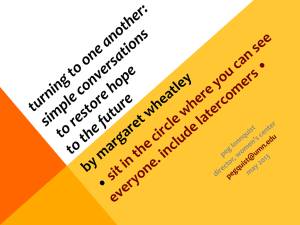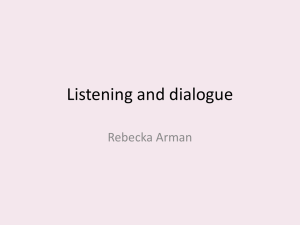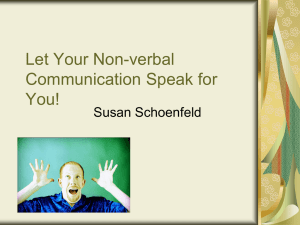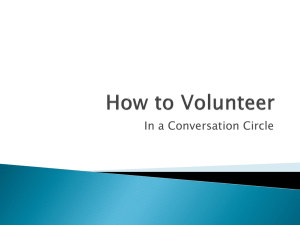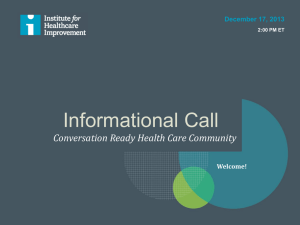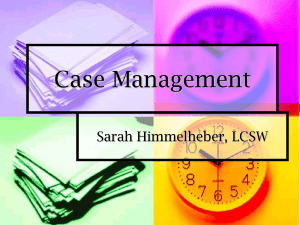05 - PowerPoint Slides
advertisement
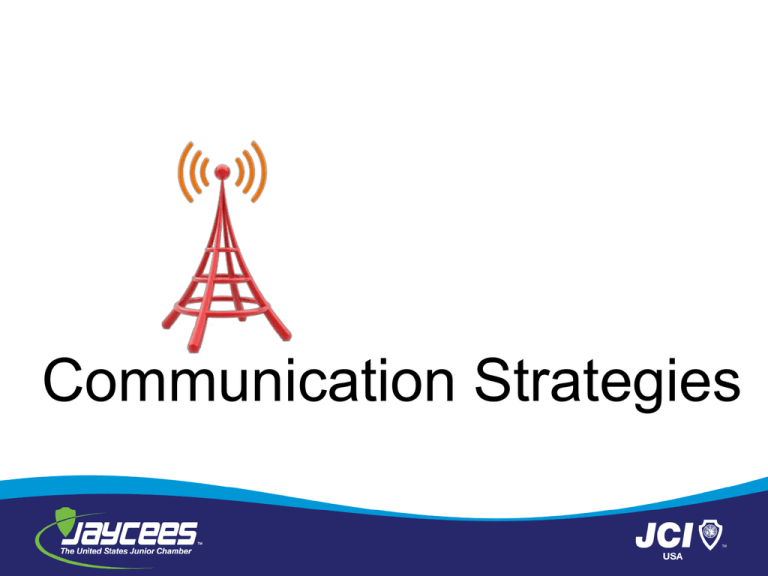
Communication Strategies Module One: Getting Started Welcome to the Communication Strategies workshop. For the better part of every day, we are communicating to and with others. Whether it’s the speech you deliver in the boardroom, the level of attention you give your spouse when they are talking to you, or the look that you give to the cat, it all means something. This workshop will help participants understand the different methods of communication and how to make the most of each of them. Wise men talk because they have something to say; fools, because they have to say something. Plato Workshop Objectives • • • • • • • • • • • • Understand what communication is Identify ways that communication can happen Identify barriers to communication and how to overcome them Develop their non-verbal and paraverbal communication skills Use the STAR method to speak on the spot Listen actively and effectively Ask good questions Use appreciative inquiry as a communication tool Adeptly converse and network with others Identify and mitigate precipitating factors Establish common ground with others Use “I” messages Pre-Assignment Review • The purpose of the Pre-Assignment is to get you thinking about the communication strategies that you are already using and where you need to improve. • Think of a situation where you missed an opportunity because of a lack of communication, and what communication skills in particular could have alleviated the problem. Take some time now to share your thoughts. Module Two: The Big Picture When we say the word, “communication,” what do you think of? Many people will think of the spoken word. People who are hearing impaired, however, might think of sign language. People who are visually impaired might think of Braille as well as sounds. In this module, we will explore the different ways in which we communicate. The more elaborate our means of communication, the less we communicate. Joseph Priestley What is Communication? The effectiveness of your communication can have many different effects on your life, including items such as: • • • • • • Level of stress Relationships with others Level of satisfaction with your life Productivity Ability to meet your goals and achieve your dreams Ability to solve problems How Do We Communicate? We communicate in three major ways: • Spoken: There are two components to spoken communication. Verbal: This is what you are saying. Paraverbal: This means how you say it – your tone, speed, pitch, and volume. • Non-Verbal: These are the gestures and body language that accompany your words. Some examples: arms folded across your chest, tracing circles in the air, tapping your feet, or having a hunched-over posture. • Written: Communication can also take place via fax, e-mail, or written word. Other Factors in Communication Other communication factors that we need to consider: • Method: The method in which the communicator shares his or her message is important as it has an effect on the message itself. • Mass: The number of people receiving the message. • Audience: The person or people receiving the message affect the message, too. Module Three: Understanding Communication Barriers communication is far more complicated than it seems. Let’s look Like most things in life, however, at some of the most common barriers and how to reduce their impact on communication. When you come right down to it, how many people speak the same language even when they speak the same language? Russell Hoban An Overview of Common Barriers Common things that people list as barriers include: • I can’t explain the message to the other person in words that they understand. • I can’t show the other person what I mean. • I don’t have enough time to communicate effectively. • The person I am trying to communicate with doesn’t have the same background as me, and is missing the bigger picture of my message. Language Barriers Of course, one of the biggest barriers to written and spoken communication is language. This can appear in three main forms: • The people communicating speak different languages. • The language being used is not the first language for one or more people involved in the communication. • The people communicating speak the same language, but are from different regions and therefore have different dialects and or unique subtleties. Cultural Barriers • There can also be times when people speak the same language, but are from a different culture, where different words or gestures can mean different things. • If you have the opportunity to prepare, find out as much as you can about the other person’s culture and background, and how it differs from yours. Differences in Time and Place So how can you get over the challenges of time and place? First, identify that there is a difference in time and place. Next, try these tips to reduce its impact. • Make small talk about the weather in your respective regions. This will help you get a picture of the person’s physical environment. • Try to set up phone calls and meetings at a time that is convenient for you both. • If appropriate, e-mail can be an “anytime, anywhere” bridge. For example, if Bill had sent Joe an e-mail describing the problem, Joe could have addressed it at a better time for him, such as later on in the day. Clearly, this is not always practical (for example, if the problem is urgent, or if it is a complicated issue that requires extensive explanation), but this option should be considered. Module Four: Paraverbal Communication Skills Try saying these three sentences out loud, placing the emphasis on the underlined word. • “I didn’t say you were wrong.” (Implying it wasn’t me) • “I didn’t say you were wrong.” (Implying I communicated it in another way) • “I didn’t say you were wrong.” (Implying I said something else) Many attempts to communicate are nullified by saying too much. Robert Greenleaf The Power of Pitch • Pitch can be most simply defined as the key of your voice. A high pitch is often interpreted as anxious or upset. A low pitch sounds more serious and authoritative. • If you naturally speak in a very high-pitched or lowpitched voice, work on varying your pitch to encompass all ranges of your vocal cords. The Truth about Tone Here are some tips on creating a positive, authoritative tone. • • • • Try lowering the pitch of your voice a bit. Smile! This will warm up anyone’s voice. Sit up straight and listen. Monitor your inner monologue. Negative thinking will seep into the tone of your voice. The Strength of Speed • • • The pace at which you speak also has a tremendous effect on your communication ability. Speed also has an effect on the tone and emotional quality of your message. One easy way to check your pitch, tone, and speed is to record yourself speaking. Module Five: Non-Verbal Communication The first goal of this module: to help you understand how to use body language to become a more effective communicator. Another goal, one which you will achieve with time and practice, is to be able to interpret body language, add it to the message you are receiving, and understand the message being sent appropriately. The most important thing in communication is to hear what isn't being said. Peter Drucker Understanding the Mehrabian Study In 1971, psychologist Albert Mehrabian published a famous study called Silent Messages. In it, he made several conclusions about the way the spoken word is received. Although this study has been misquoted often throughout the years, its basic conclusion is that 7% of our message is verbal, 38% is paraverbal, and 55% is from body language. All About Body Language THE WAY THAT WE ARE STANDING OR SITTING • • • Sitting hunched over typically indicates stress or discomfort. Leaning back when standing or sitting indicates a casual and relaxed demeanor. Standing ramrod straight typically indicates stiffness and anxiety. THE POSITION OF OUR ARMS, LEGS, FEET, AND HANDS • • Crossed arms and legs often indicate a closed mind. Fidgeting is usually a sign of boredom or nervousness. FACIAL EXPRESSIONS • • • Smiles and frowns speak a million words. A raised eyebrow can mean inquisitiveness, curiosity, or disbelief. Chewing one’s lips can indicate thinking, or it can be a sign of boredom, anxiety, or nervousness. Interpreting Gestures GESTURE INTERPRETATION Nodding head Yes Shaking head No Moving head from side to side Maybe Shrugging shoulders Not sure; I don’t know Tapping hands or fingers Bored, anxious, nervous Shaking index finger Angry Thumbs up Thumbs down Agreement, OK Disagreement, not OK Handshake Waving both hands over head Welcome, introduction Help, attention Module Six: Speaking Like a STAR Now that we have explored all the quasi-verbal elements of communication, let’s look at the actual message you are sending. You can ensure any message is clear, complete, correct, and concise, with the STAR acronym. This module will explore the STAR acronym in conjunction with the six roots of open questions which will be explored in more detail later on in the workshop. Be sincere; be brief; be seated. Franklin D. Roosevelt S = Situation First, state what the situation is. Try to make this no longer than one sentence. If you are having trouble, ask yourself, “Where?”, “Who?”, and, “When?”. This will provide a base for message so it can be clear and concise. Example: “On Tuesday, I was in a director’s meeting at the main plant.” T = Task Next, briefly state what your task was. Again, this should be no longer than one sentence. Use the question, “What?” to frame your sentence, and add the “Why?” if appropriate. Example: “I was asked to present last year’s sales figures to the group.” A = Action Now, state what you did to resolve the problem in one sentence. Use the question, “How?” to frame this part of the statement. The Action part will provide a solid description and state the precise actions that will resolve any issues. Example: “I pulled out my laptop, fired up PowerPoint, and presented my slide show.” R = Result Last, state what the result was. This will often use a combination of the six roots. Again, a precise short description of the results that come about from your previous steps will finish on a strong definite note. Example: “Everyone was wowed by my prep work, and by our great figures!” Summary • Let’s look at a complete example using STAR. Let’s say you’re out with friends on the weekend. Someone asks you what the highlight of your week at work was. • You respond: “On Tuesday, I was in a director’s meeting at the main plant. I was asked to present last year’s sales figures to the group. I pulled out my laptop, fired up PowerPoint, and presented my slide show. Everyone was wowed by my prep work, and by our great figures!” Module Seven: Listening Skills When people talk, listen completely. So far, we have discussed all the components of sending a message: • • • Non-verbal Para-verbal Verbal Now, let’s turn the tables and look at how to effectively receive messages. Ernest Hemingway Seven Ways to Listen Better Today 1. 2. 3. 4. 5. 6. 7. When you’re listening, listen. Avoid interruptions. Aim to spend at least 90% of your time listening and less than 10% of your time talking. When you do talk, make sure it’s related to what the other person is saying. Do not offer advice unless the other person asks you for it. If you are not sure what they want, ask! Make sure the physical environment is conducive to listening. Try to reduce noise and distractions. If it is a conversation where you are required to take notes, try not to let the note-taking disturb the flow of the conversation. Understanding Active Listening There are three basic steps to actively listening. 1. Try to identify where the other person is coming from. This concept is also called the frame of reference. 2. Listen to what is being said closely and attentively. 3. Respond appropriately, either non-verbally (such as a nod to indicate you are listening), with a question (to ask for clarification), or by paraphrasing. Sending Good Signals to Others • • • NON-VERBAL: As shown in the Mehrabian study, body language plays an important part in our communications with others. QUASI-VERBAL: Fillers words like, “uh-huh,” and “mm-hmmm,” show the speaker that you are awake and interested in the conversation. VERBAL: Asking open questions using the six roots discussed earlier, paraphrasing, and asking summary questions. Module Eight: Asking Good Questions Good questioning skills are another building block of successful communication. We have already encountered several possible scenarios where questions helped us gather information, clarify facts, and communicate with others. In this module, we will look closer at these questioning techniques that you can use throughout the communication process. The important thing is not to stop questioning. Curiosity has its own reason for existing. Albert Einstein Open Questions Open questions use one of six words as a root: • Who? • What? • Where? • When? • Why? • How? Closed Questions Closed questions are the opposite of open questions; their very structure limits the answer to yes or no, or a specific piece of information. Some examples include: • • • Do you like chocolate? Were you born in December? Is it five o’clock yet? Probing Questions • • • • • CLARIFICATION: By probing for clarification, you invite the other person to share more information so that you can fully understand their message. COMPLETENESS AND CORRECTNESS: These types of questions can help you ensure you have the full, true story. DETERMINING RELEVANCE: This category will help you determine how or if a particular point is related to the conversation at hand. DRILLING DOWN: Use these types of questions to nail down vague statements. Useful helpers include: SUMMARIZING: These questions are framed more like a statement. They pull together all the relevant points. Module Nine: Appreciative Inquiry Traditional communication often focuses on what is wrong and how we can fix it. Think back to your last performance review, visit to the doctor, or your latest disagreement with a friend or spouse. Appreciative inquiry does the opposite: it focuses on what is right and how we can make it better. Many organizations have found it to be a refreshing, energizing way of approaching problems and revitalizing their people. If you ask the wrong question, of course, you get the wrong answer. Amory Lovins The Purpose of AI To understand the purpose of Appreciative Inquiry, let’s look at each of its parts. • Appreciate is defined by the Random House dictionary as, “to value or regard highly; to be fully conscious of; be aware of; detect; to rise in value.” • In the same dictionary, inquiry is defined as, “the act of inquiring or of seeking information by questioning.” The Four Stages • What processes could work? • What processes are working? • Lets's give it a try! Discover Dream Destiny Design •What would those processes look like? •How could we implement them? Examples and Case Studies Appreciative inquiry has been used in many different ways in many different organizations. Some projects where it has been a key tool include: • Creation of learning network for organizational psychologists at the California School of Professional Psychology. • Process improvement at John Deere that resulted in millions of dollars in savings. • Relief efforts for children orphaned by AIDS in Zimbabwe. • Integration of mental health services in England. Module Ten: Mastering the Art of Conversation Engaging in interesting, memorable small talk is a daunting task for most people. How do you know what to share and when to share it? How do you know what topics to avoid? How do you become an engaging converser? Most experts propose a simple three-level framework that you can use to master the art of conversation. Two monologues do not make a dialogue. Jeff Daly Level One: Discussing General Topics • • • At the most basic level, stick to general topics: the weather, sports, noncontroversial world events, movies, and books. This is typically what people refer to when they say, “small talk.” At this stage, you will focus on facts rather than feelings, ideas, and perspectives. Death, religion, and politics are absolute no-no’s. If someone shares a fact that you feel is not true, try to refrain from pointing out the discrepancy. Level Two: Sharing Ideas and Perspectives • If the first level of conversation goes well, the parties should feel comfortable with each other and have identified some common ground. Now it’s time to move a bit beyond general facts and share different ideas and perspectives. • Although this level of conversation is the one most often used, and is the most conducive to relationship building and opening communication channels, make sure that you don’t limit yourself to one person in a large social gathering. Level Three: Sharing Personal Experiences This is the most personal level of conversation. This is where everything is on the table and personal details are being shared. This level is typically not appropriate for a social, casual meeting. However, all of the skills that we have learned today are crucial at this stage in particular: when people are talking about matters of the heart, they require our complete attention, excellent listening skills, and skilled probing with appropriate questions. Our Top Networking Tips If you’re in the middle of a social gathering, try these networking tips to maximize your impact and minimize your nerves. • Before the gathering, imagine the absolute worst that could happen and how likely it is. • Remember that everyone is as nervous as you are. Focus on turning that energy into a positive force. • To increase your confidence, prepare a great introduction. • Start a competition with a friend: see how many people each of you can meet before the gathering is over. • Join a group of odd-numbered people. • Try to mingle as much as possible. • When you hear someone’s name, repeat the introduction in your head. • Mnemonics are a great way to remember names. Module Eleven: Advanced Communication Skills During this workshop, we have learned a lot about communication. We would like to wrap things up with a brief discussion on a few advanced communication topics. Adding these skills to your toolbox and using them regularly will make you a more efficient, effective, communicator. The relationship is the communication bridge between people. Alfred Kadushin Understanding Precipitating Factors • On a particularly good day, everything may go your way and make you feel like you’re on top of the world. But on a bad day, unfortunate events can likewise snowball, increasing their negative effect exponentially. • Successful communicators are excellent at identifying precipitating factors and adjusting their approach before the communication starts, or during it. Understanding the power of precipitating factors can also help you de-personalize negative comments. Establishing Common Ground • Finding common ties can be a powerful communication tool. Think of those times when a that the person next to you on the train grew up in the same town that you did, or that the co-worker you never really liked enjoys woodworking as much as you do. • Whenever you are communicating with someone, whether it is a basic conversation, a problem-solving session, or a team meeting, try to find ways in which you are alike. Using “I” Messages • • Framing your message appropriately can greatly increase the power of your communication. Instead of starting a sentence with “you,” try using the “I message” instead for feedback. This format places the responsibility with the speaker, makes a clear statement, and offers constructive feedback. Module Twelve: Wrapping Up Although this workshop is coming to a close, we hope that your journey to improve your communication skills is just beginning. Please take a moment to review and update your action plan. This will be a key tool to guide your progress in the days, weeks, months, and years to come. We wish you the best of luck on the rest of your travels! Communication is the real work of leadership Nitin Nohria Words from the Wise • HUBERT H. HUMPHREY: The right to be heard does not automatically include the right to be taken seriously. • MICHEL DE MONTAIGNE: I quote others only in order the better to express myself. • WOODROW WILSON: If I am to speak ten minutes, I need a week for preparation; if fifteen minutes, three days; if half an hour, two days; if an hour, I am ready now.
